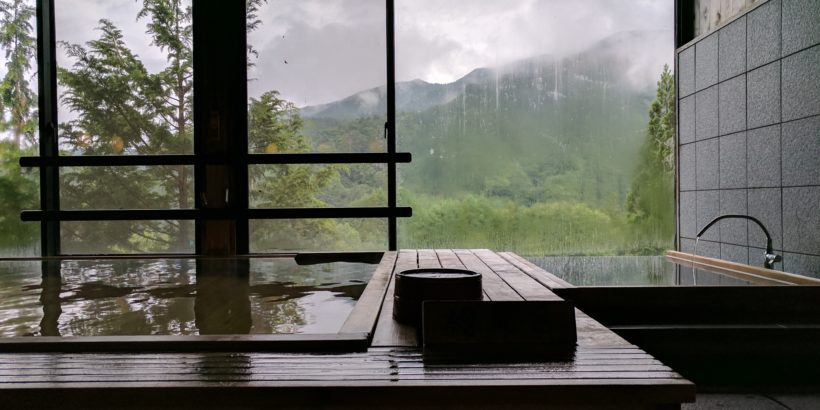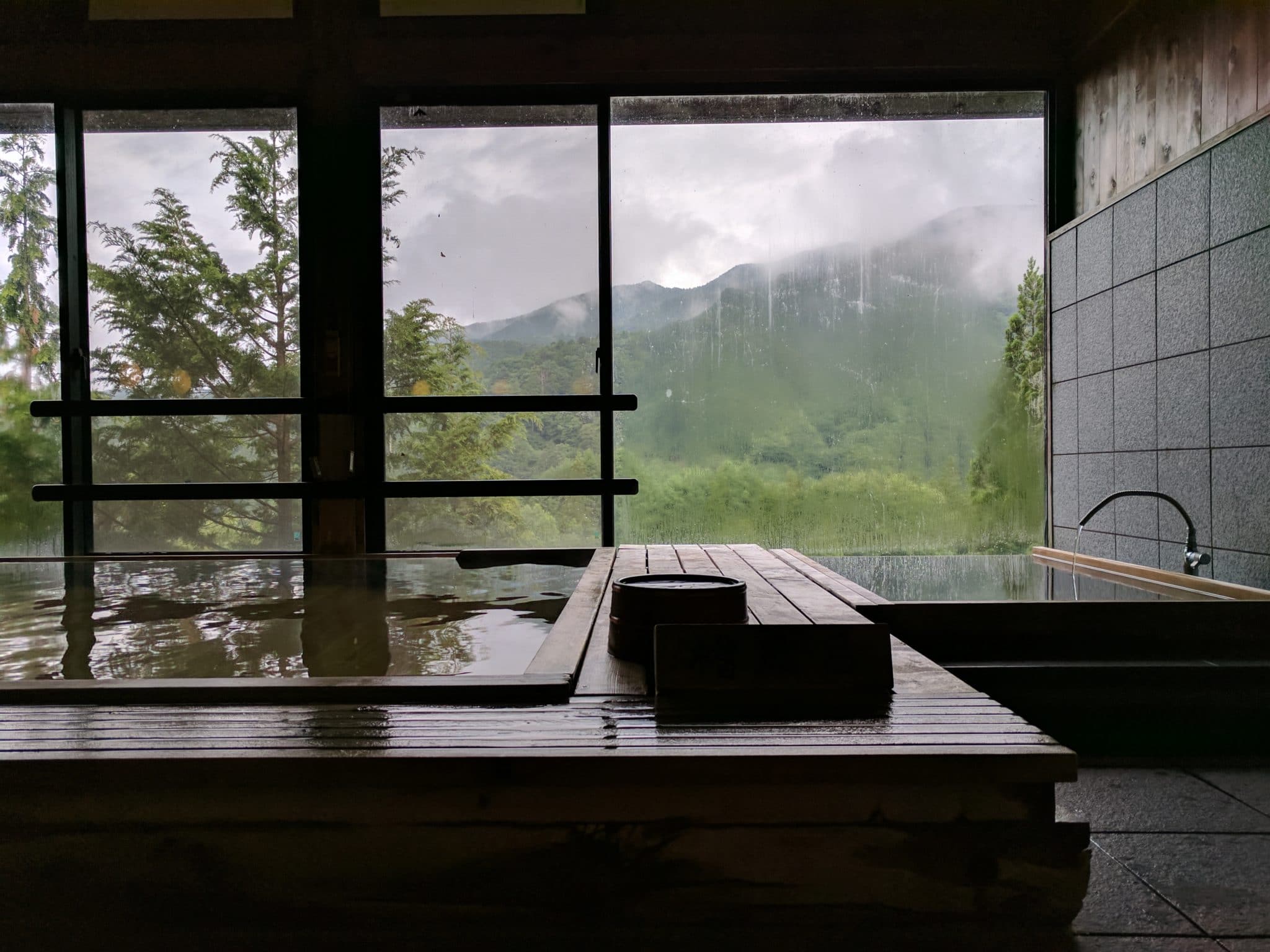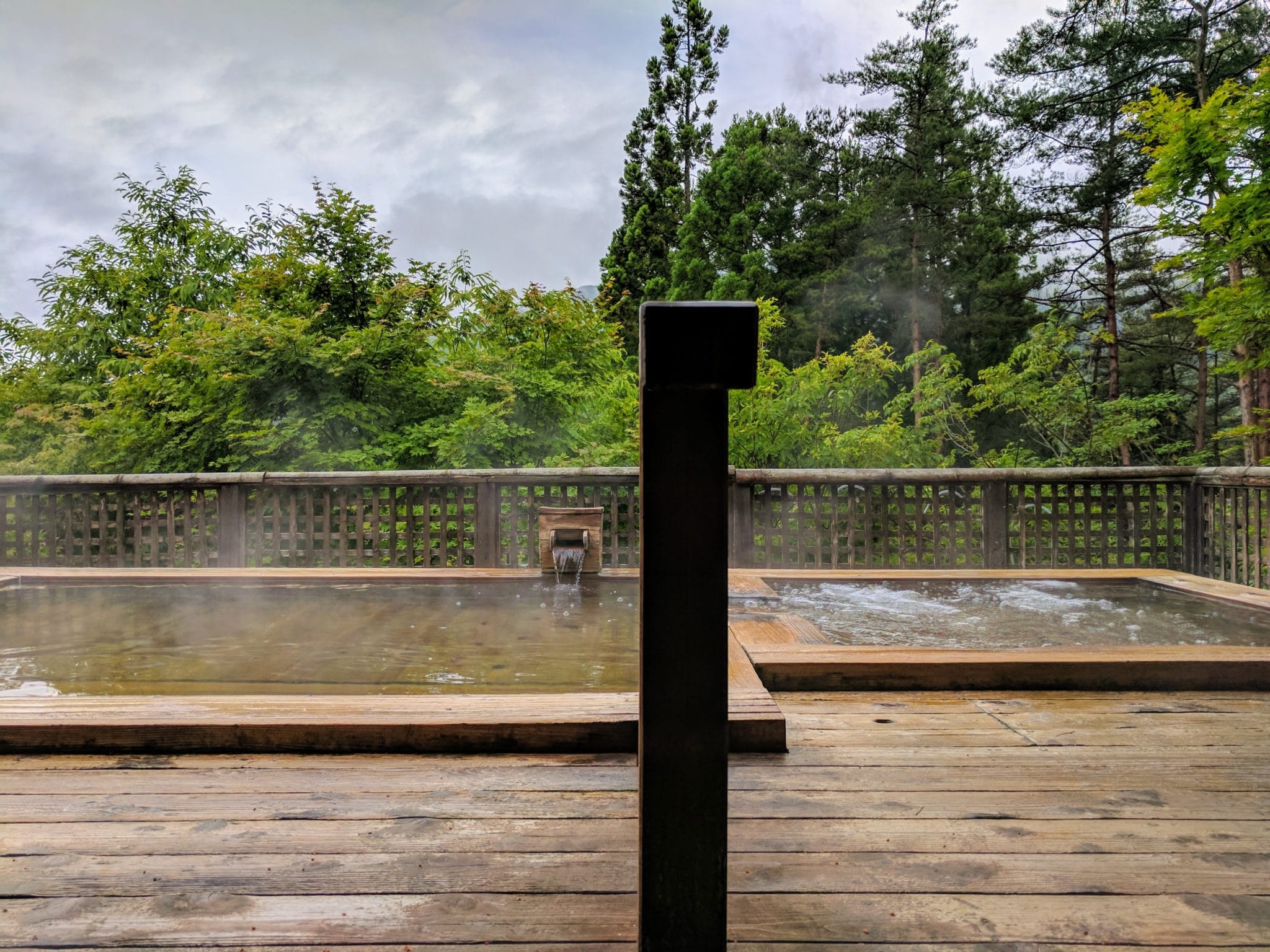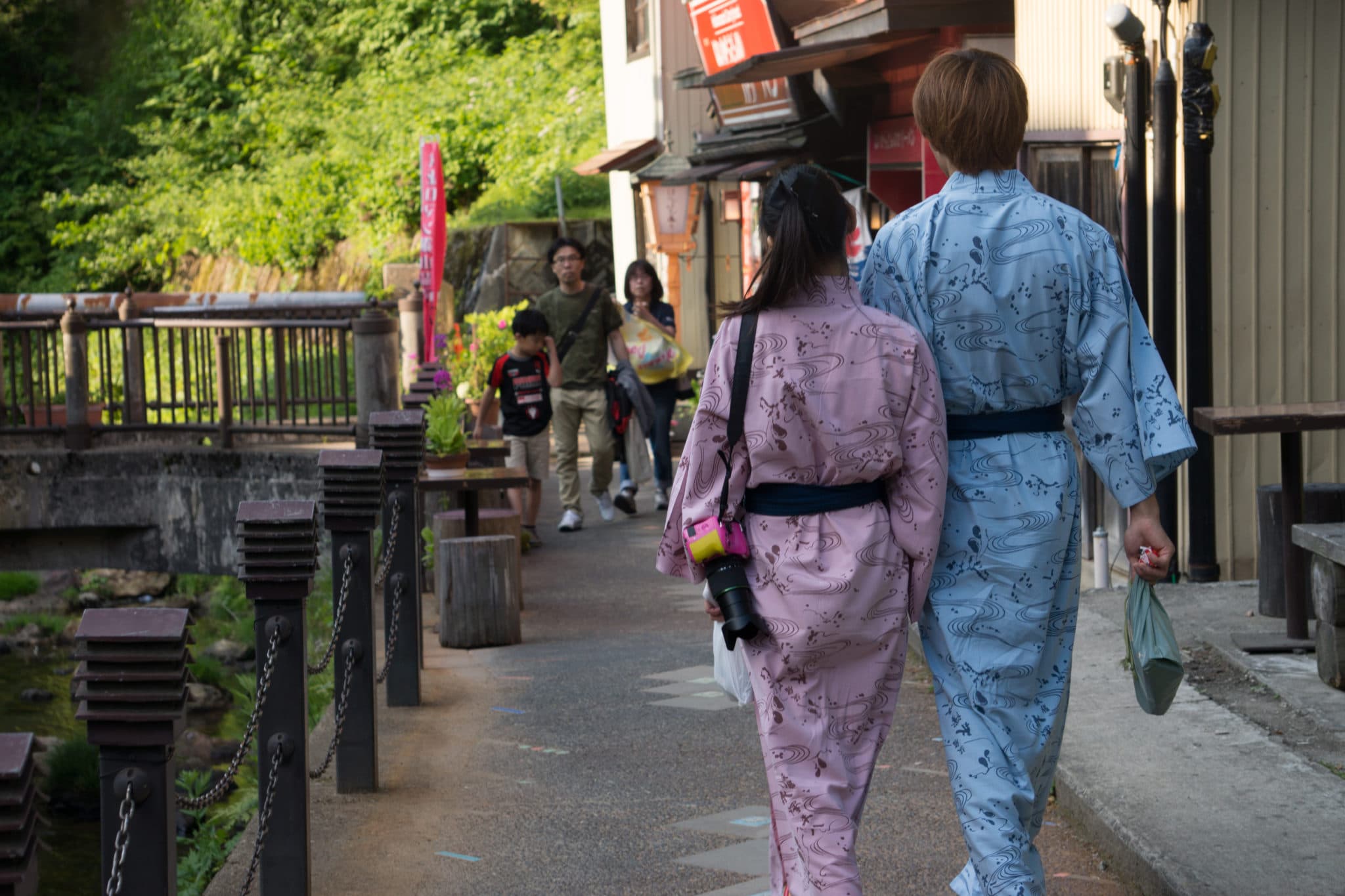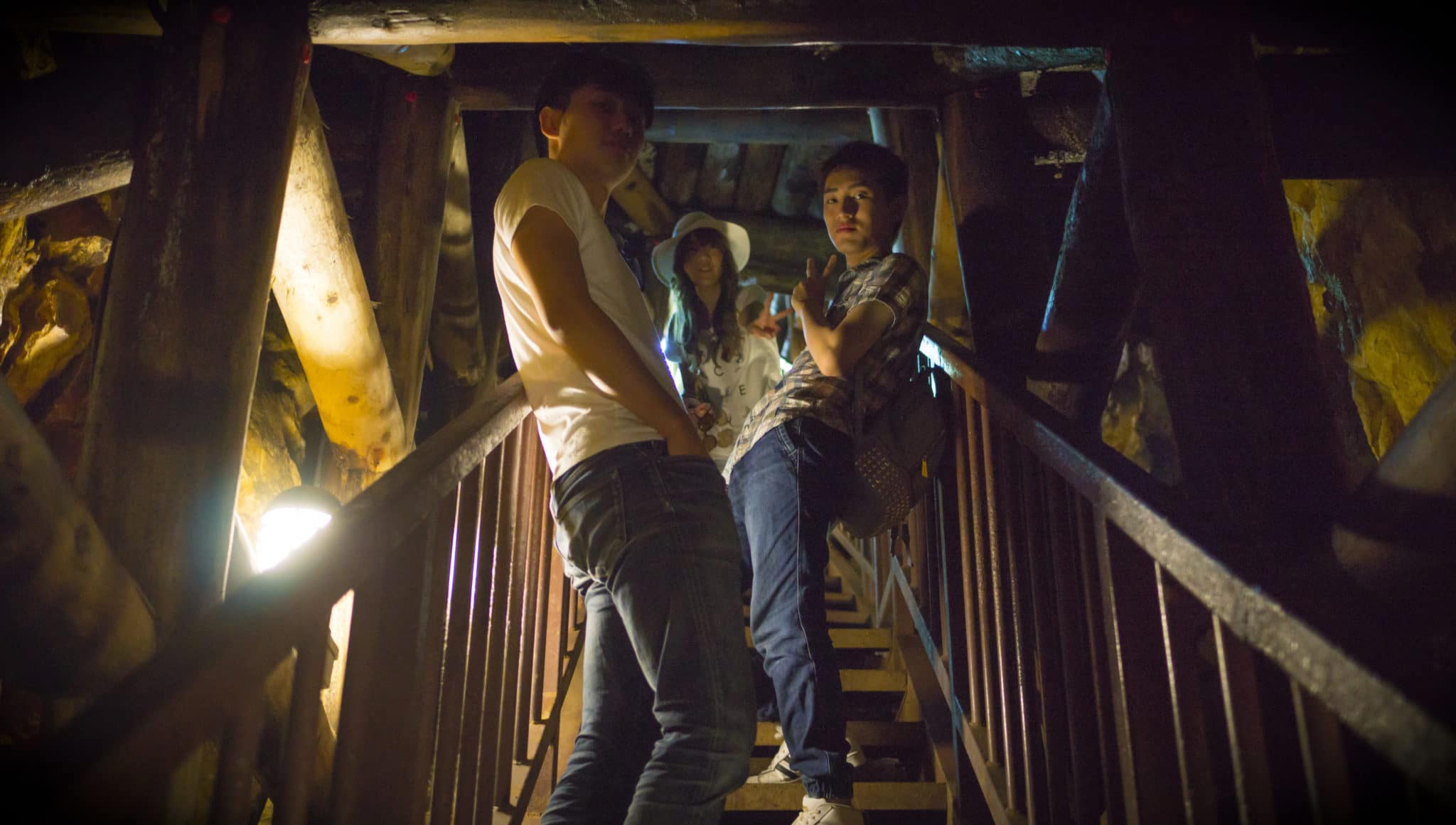Japan is one of my favorite countries for food and activities. One of the best things to do in Japan is going to an onsen, also known as a Japanese bathhouse. Visiting an onsen and bathing in one is probably one of the most relaxing activities you could do while you’re in Japan — no matter if you’re in the countryside or city, onsens are everywhere.
In this article, I explain what an onsen is, what type of standards and expectations you should have for onsens, and where you can visit some of the best onsens in all of Japan.
Table of Contents
What is a onsen?
Onsen is the word for a public bathhouse that you will find all over Japan. Bathers will bath naked with their specific gender as males and females have designated baths. Onsens might be standalone while other onsens might be part of ryokans (an inn), which will be called onsen ryokans. Onsens can be cheap or expensive and all you need is your clothes as onsens will provide everything you will need or possibly want before or after your bath.
Below I go over the standards of onsens and what you might expect at your average onsen or onsen ryokan.
Standards of onsens
Onsens can come in many shapes and sizes.
Some onsens will offer a very luxurious environment while other onsens offer the bare bones in both facilities and amenities. However, onsens typically are all the same when it comes to offering a changing room, showers, and bath.
Tip: Use WalletFlo for all your credit card needs. It’s free and will help you optimize your rewards and savings!
Everything you can imagine is provided (maybe with a fee)
You might think onsens nickle and dime you when it comes to toiletries or bath accessories, but in reality the fee you pay for the onsen includes almost everything you can think of.
- Shampoo
- Conditioner
- Body wash
- Soap
- Hair dryer
- Combo
- Hairbrush
- Towels
Non-essential items below might have to be rented or purchased at cheaper onsens, but are certainly free at averaged priced and more expensive onsens.
- Face wash
- Makeup pads
- Razors
- Hair iron
- etc.
In many onsens, you won’t have to rent or purchase non-essential items, but do keep in mind that the cheaper the onsen is, you might have to pay extra for non-essential items.
Most onsen ryokans will offer everything you can think of without the need to rent or purchasing non-essential items.
Sometimes I have found products that are crazy good at more expensive onsens making me wish I could bring it home and at other cheaper onsens the products are just okay.
You will be naked
The whole point of an onsen is to bathe yourself. So, in retrospect, you have to be naked. Expect most onens not to allow any type of swimwear, so you have to be naked if you want to actually shower and bathe at an onsen.
I am personally self conscious, so the first time going to an onsen I was nervous, but in reality it’s a wonderful experience. It’s something about being with strangers and/or friends that makes bathing in an onsen a wonderful experience to remove all the worries in your life.
If you absolutely cannot bathe nude, you can find onsens that allow swimwear. Unfortunately, they aren’t all that common and typically are found in more touristy places.
Cubbies or lockers
At any onsen you visit, there will a changing room with lockers or cubbies. Most of the time they are just open cubbies with baskets, where you don’t need a special key to unlock. I’ve never lost anything in these cubbies. I have left my phone and wallet before many of times, but they were always there when I came back to the cubby. It’s probably because Japan is one of the safest countries in the world.
You can change out and into your clothes in this cubby room. In the cubby room, you will usually find a private toilet, towels, sinks, and other toiletries. There are usually even scales to weigh yourself and sometimes cold or hot tea to drink.
Shower before getting into the onsen (bath)
It’s a must to take a shower before getting into the onsen. There will be places where you can either stand or sit while showering. You will find shampoo, conditioner, body wash, mirror, and sometimes face wash at each shower. Showers will also have a bucket where it’s fun to rinse yourself off. I never realized how much of a joy it can be to shower before and after bathing at an onsen.
Some onsens will have dividers between each shower, but in most cases the showers are in a row without a dividers between each one, but typically there isn’t.
Going with your friends
It’s normal to go to an onsen with your friends and not uncommon to see younger and older groups of people bathing together and talking. While you might think going with your friends might be weird, it’s actually pretty fun. You tend to be relaxed because of the water and talk without any distractions.
Family friendly
Most onsens are family friendly where children or even infants can come into the onsen. Onsen goers have no problem taking kids or even having strangers kids in the baths. Bath toys aren’t usually welcomed, but some family onsens might allow bath toys as they might want to cater more to families than the general population.
Just remember to watch your kids so they don’t get in trouble. You should also take note that onsens can be very hot, so the younger the child or infant, the water might not be so good for them. So, limit your time.
Going alone
Yes, it’s perfectly normal to go to an onsen alone. I have gone to an onsen alone and enjoyed it as much as going with friends. Visiting an onsen is all about relaxation. It’s amazing to go to an onsen and look out of a winder to see something peaceful, I highly recommend trying an onsen alone if you can.
Private couple onsens
Some private onsens are available at higher end places for an extra fee. These can be awesome if you’re traveling with your partner and want to enjoy a bath and shower within your own privacy. Expect the same onsen experience, typically indoor and outdoor onsen all for you and another person, just smaller.
Unique minerals
There are different types of onsens. You will have natural and articifial onsens. Artificial onsens aren’t bad, but natural onsens are a different world. Natural onsens tend to have unique smells, smoothness, texture, etc. The type of onsens you can encounter would be:
- Sulphur onsen (硫黄泉, iō-sen)
- Sodium chloride onsen (ナトリウム泉, natoriumu-sen)
- Hydrogen carbonate onsen (炭酸泉, tansan-sen)
- Iron onsen (鉄泉, tetsu-sen)
Sulphur onsens are by far the most common onsen you can find around Japan. Sometimes Sulphur is not the most pleasant smell, but it does make your skin feel amazing and feel relaxed in a unique way.
With these types of minerals you will tend to have different styles of onsens eggs, which are commonality at natural onsens.
Onsen eggs
Onsen eggs are basically eggs boiled in the onsen water. Of course they use clean different onsen water that hasn’t touched human skin.
Onsen eggs tend to taste and have a slightly different texture than regularly boiled eggs. In fact, when I first tried onsen eggs for the first time, I was surprised how there was an actual difference. You can typically find onsen eggs at many onsen ryokans, but also at some onsen houses too.
Don’t be loud
Onsens are meant to be a quiet environment, and if it’s not a quiet environment it will anger locals, especially regulars. Library talking is okay, but anything louder can be annoying to other onseners. You should also not splash around water if you are with friends or your partner as others around you will definitely not enjoy it.
While some children can lightly splash around, make sure your child is aware of the onsen culture of relaxation and not running around.
However, if you and your buddies are the only ones in the onsen with no one else around, you can be as loud and splash around a little bit. Just know that most male and female onsens are right next to each other with a dividing wall, so being too loud could have the other gender get annoyed.
Tattoos might be prohibited
Yes, that’s right, if you have body ink, an onsen might turn you away. Sometimes other onseners might tell on you by saying to the onsen staff. It’s because tattoos in Japan are usually associated with rebels. While Japan is slowly opening up to the idea of tattoos, many locals might still have a negative connotation of tattoos.
If you have a tattoo, I highly suggest finding an onsen that is accepting to tattoo onseners.
Onsens are hot
You might not realize it, but an onsen can be very hot. Some are slightly hotter than others. So you need to listen to your body and know your own tolerance. Also, don’t stay in too long as health side effects can occur.
I have been to a few onsens that are extremely hot, almost unbearable. Definitely don’t go to an onsen if you have high blood pressure.
Tip: Use WalletFlo for all your credit card needs. It’s free and will help you optimize your rewards and savings!
Yukatas are fun to wear and walk around in onsen towns
Think of a yukata as a more casual version of a kimono. You will typically be given one at onsens, and most definitely be given one to borrow at onsen ryokans. They are typically worn around town, even if you wanted to go out to eat wearing it, it’s okay.
They make yukatas for all ages and body sizes, so you don’t have to worry about it being too big or small.
I personally love wearing a yukata. Think of it as a bathrobe, but much better.
Where to find the best onsens in Japan
While you may already know Hakone, you might not realize that there are many onsen towns and villages out there that make Hakone look like an overpriced just okay tourist town in comparison.
Ginzan Onsen Village, Yamagata
Located in Yamagata Prefecture, Ginzan Onsen Village is one of the most beautiful onsen villages out there. With dozens of natural onsen ryokans, which some allow you to access the onsen without staying. It’s one of my favorite onsen villages in Japan.
During my first visit to Ginzan Onsen Village, I fell in love. Views from many outside onsens were breathtaking and calming. Then on top of that, onsens here are natural. During the summer it’s not crowded, but during the winter many people visit, as onsens are always better during the winter.
The whole village is picturesque, and you can walk around wearing your Yakata. Many Japanese all over Japan will go to Ginzan for onsens. In fact, some animes, like Spirited Away, have based the buildings in the anime off of Ginzan Onsen Village buildings. So, you can expect it to be worth your visit, even if it’s only accessible by car.
Kurokawa Hot Spring Ryokan Association, Kumamoto
Kumamoto is known for its bear mascot, but also known for its wonderful landscapes. Kurokawa Hot Spring Ryokan Association is cluttered with many onsens and ryokans for a relaxing day or two. With over 25 onsen ryokans, you will be able to stay and relax overnight while some allow daily usage of the onsen without staying overnight.
The most beautiful times to visit would be during the fall when the trees change colors and the weather is chilly. During the spring you can see flowers and trees blooming, aka sakura season for sakura trees, normally mid March. My friends that have been here loved it and usually went back annually for some relaxation between semesters at university.
Kusatsu, Gunma
Kusatsu is probably one of the most famous quality towns for onsens near Tokyo. It holds some of the most beautiful natural onsens in the mountains of Gunma. A short drive away, you also have the Jigokudani Monkey Park, one of the most unique places to visit during the winter as monkeys soak up the onsen water surrounded by snow.
If you had to stay at any onsen ryokan town, Kusatsu would be great for all seasons as it can cater to outdoor lovers and home bodies as the mountains are some of the most beautiful mountains in all of Japan. I am planning to visit during this March with friends as they really want to go back and it’s on my list of must visits.
Final word
I hope this article gave you a better idea of what an onsen is. Going to an onsen is definitely a recommended to-do for anyone who visits Japan with friends, family, or even alone. If you end up visiting an onsen, tell us what you thought of the experience in the comments below.
This article was originally published by Steve Smith.
Daniel Gillaspia is the Founder of UponArriving.com and the credit card app, WalletFlo. He is a former attorney turned travel expert covering destinations along with TSA, airline, and hotel policies. Since 2014, his content has been featured in publications such as National Geographic, Smithsonian Magazine, and CNBC. Read my bio.

